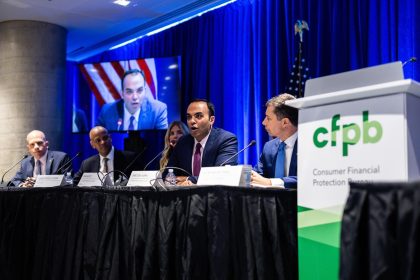OBSERVATIONS FROM THE FINTECH SNARK TANK
Spurred by the spike in online and mobile shopping during the pandemic, the popularity of buy now, pay later (BNPL) payment plans—among consumers and merchants, at least—has skyrocketed in the past few years. It’s time for banks—and all BNPL detractors—to get with the program.
BNPL Is Taking Off
According to Adobe Analytics, buy now, pay later plans were used to generate a record $16.6 billion this past November and December, accounting for 13% of total eCommerce holiday sales in the US. A New York Federal Reserve Bank study answered some questions about BNPL:
- How many people use BNPL? Nearly two-thirds of consumers have been offered a BNPL option when shopping online, with roughly three in ten of them using the service—equating to about one in five of all respondents.
- How do BNPL users pay for their purchases? Among BNPL users, 77% made installment repayments using a debit card, bank account, or bank check; 10% used a credit card; 6% used a prepaid card; and 8% used a payment service such as Venmo.
- Who uses BNPL? BNPL use is most prevalent among females, renters, individuals without a college degree, lower income individuals, and consumers with credit scores below 620.
BNPL Has Its Detractors and Downsides
With demographics like that, it’s no wonder that customer advocate groups aren’t big fans of the service, claiming it contributes to consumers’ debt load. And with credit card debt at an all-time high, extra debt from BNPL exacerbates an already challenging financial situation for many consumers. The New York Fed cautioned:
“BNPL may attract—and could ultimately harm—financially fragile individuals. That could ultimately negatively impact consumers at a time when they’re facing mounting credit card debt, strikingly high interest rates, still-high inflation, a slowing job market, a potential government shutdown, and the return of student loan payments.”
The Office of the Comptroller of the Currency (OCC) wrote:
“BNPL structures may present elevated first payment default risk from fraud or borrower oversight. With loan payments typically tied to a debit or credit card, overextension can also result in secondary fees charged to the borrower, such as overdraft, non-sufficient funds, and late fees.”
BNPL Isn’t Going Away
All good points from the Fed and the OCC. Despite the warnings, BNPL activity continues to rise.
No one should be surprised.
Have reports of the dangers of smoking, drinking, eating too much (or poorly), reckless driving, etc. stopped those behaviors? Of course not.
Remember that chant “we want what we want, and we want it now!”? That’s buy now, pay later’s motto.
Banks Are Losing Out To Buy Now, Pay Later
The rise in BNPL is bad news for banks.
It’s hard to estimate how much payment volume banks lose because of BNPL. Given the demographics of BNPL users, it’s a good bet that debit cards—which generate interchange income for banks—are their payment form of choice, and that BNPL purchases cannibalize debit card volume.
In addition, banks lose interchange fees when users pay their BNPL bill directly from their bank account, or with a bank check, prepaid debit card, or Venmo.
Can Banks Compete For BNPL?
This threat, if not reality, of lower interchange revenue is too much for banks to ignore in 2024. As Nandan Sheth, CEO of fintech Splitit, wrote:
“Banks have not moved fast to address the consumer demand for pay later solutions embedded within the merchant purchase journey. Banks miss the critical ‘in-checkout’ moment, ceding ground to fintechs with integrated installment plans.”
Sheth believes, however, that banks have advantages in terms of scale, trust, and available credit: “The key to triumph in the ongoing contest for the future of BNPL lies in synergizing the strengths of banks to offer a distinctive set of differentiators through strategic partnerships.”
Pymnts.com agrees that banks have BNPL advantages, citing two points as evidence:
- Gen Z consumers trust banks more than fintechs. Pymnts.com wrote, “43% of Gen Z consumers said brick-and-mortar banks provided peace of mind that digital-native FinTechs could not.”
- Americans trust banks to detect and prevent fraud. Banks rank highly for protecting consumers against fraud and scams, with 55% of consumers ranking banks among their top-three most trusted institutions.
Banks Have a Hard—But Doable And Necessary—Road to BNPL Success
Pymnts.com’s arguments for banks’ “inherent advantages” are misguided.
There’s little evidence that “peace of mind,” “trust,” and concerns about scams influence consumers’ BNPL purchase decisions. Consumers trust the merchants and retailers on whose sites they make purchases. And repeat BNPL users are repeat users because they trust BNPL providers like Affirm, Klarna, and PayPal.
The Battle For BNPL Isn’t Just At The Point Of Sale (Or After It)
Reality: Banks are at a disadvantage—and a serious one at that—in any quest to capture BNPL volume.
Why? Because merchants and retailers use buy now, pay later as a tool to help influence consumers’ choice of products and providers—long before the consumer is in the process of making the purchase. As I wrote in Buy Now, Pay Later: The “New” Payments Trend Generating $100 Billion In Sales:
“What’s different—and important—about Buy Now, Pay Later is its place in the customer journey. Payment options typically come at the end of the journey. Today’s BNPL services influence consumers’ choices of products and providers earlier in the journey.”
Companies like Klarna aren’t just “BNPL providers”—they’re eCommerce enablers, providing tools and technologies that help consumers make decisions about what they buy, who they buy from, and how they pay for it. These firms have:
- Become shopping destinations. Klarna’s search engine compares thousands of websites to help consumers find the best price for products. Its unbiased search tool lets users filter their search across stores by color, size, features, customer ratings, store availability and shipping options.
- Sharpened their sales attribution claims. A study from two professors at Humboldt University of Berlin found that BNPL increased the likelihood a customer would complete a purchase by 13%.
- Specialized. BNPL providers increasingly specialize in narrow product categories like LoanStar Technologies in home improvement and Prima Health Credit in elective medical procedures.
Banks’ involvement in the BNPL process comes after the sale. It’s an inherent disadvantage.
Banks Can—No, Must—Battle Back in BNPL
While megabanks like Chase have the resources to create their own BNPL programs, smaller institutions need to rely on third-party technology providers. Fortunately, the list of providers is growing with firms like LoanStar, Equipifi, Galileo, and Wisetack helping financial institutions get into the BNPL game.
Few financial institutions seem interested, however. Cornerstone’s 2023 What’s Going On In Banking study found that just 5% of banks and credit unions provided, or were planning to provide, BNPL plans.
That percentage may be higher in 2024, but it’s nowhere near what it should be. The risk of not competing in BNPL is about more than just lost interchange. It’s about:
- Deposit displacement. Affirm’s debit card’s 700,000 users rang up nearly $400 million in purchases in Q4 2023—30% of it in-store. Affirm now offers direct deposit, but hasn’t reported the number of users.
- Credit card growth. BNPL activity gives BNPL providers the data they need to identify good credit risks before established credit card issuers can—which means BNPL providers’ next move will be to issue credit cards, crowding banks out of the emerging consumer market.
- Loan growth. Establishing debit and credit card relationships with young consumers will position BNPL providers to expand—seamlessly and efficiently—into other personal loan categories, further cannibalizing banks and credit unions.
All three points paint a threatening picture for banks and credit unions. Getting into the BNPL space is a must-do.
“BNPL causes consumers to go deeper in debt” is a weak argument for not offering the service. Consumers use banks’ debit cards to buy plenty of things that aren’t good for them, and they use banks’ credit cards to run up far more debt than the average BNPL user has.
Stop making excuses and get in the game, banks.
Read the full article here

















